Nomi Prins compares four key factors — unemployment, the economy, the market, and the Federal Reserve’s response — in the crises then and now.
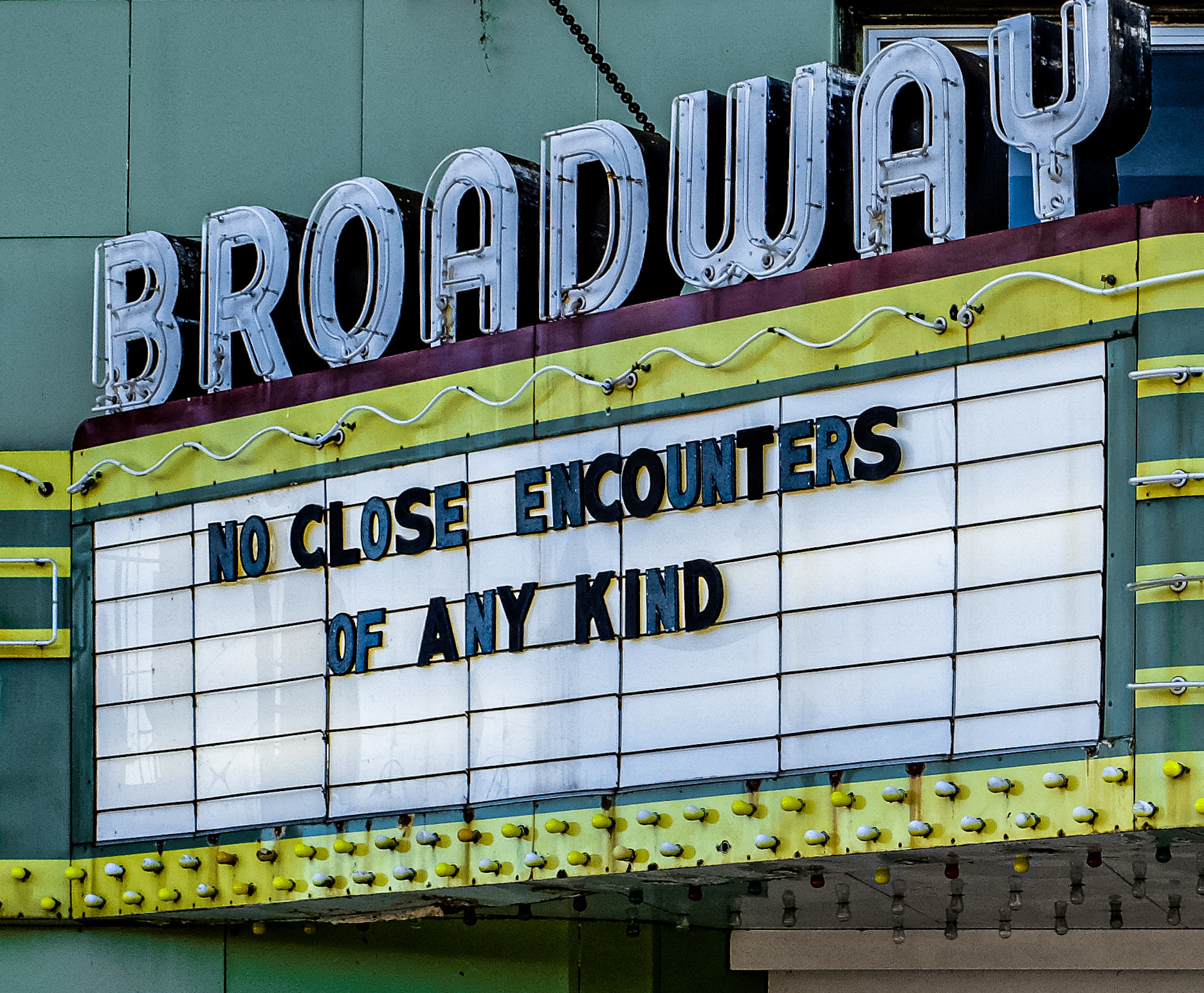
Theater marquee in Mount Pleasant, Michigan, promotes social distancing. (Dan Gaken, CC BY 2.0, Wikimedia Commons)
 Many economists believe that a recession is already underway. So do millions of Americans struggling with bills and job losses. While the ghosts of the 2008 financial crisis that sent inequality soaring to new heights in this country are still with us, it’s become abundantly clear that the economic disaster brought on by the Covid-19 pandemic has already left the initial shock of that crisis in the dust. While the world has certainly experienced its share of staggering jolts in the past, this cycle of events is likely to prove unparalleled.
Many economists believe that a recession is already underway. So do millions of Americans struggling with bills and job losses. While the ghosts of the 2008 financial crisis that sent inequality soaring to new heights in this country are still with us, it’s become abundantly clear that the economic disaster brought on by the Covid-19 pandemic has already left the initial shock of that crisis in the dust. While the world has certainly experienced its share of staggering jolts in the past, this cycle of events is likely to prove unparalleled.
The swiftness with which the coronavirus has stolen lives and crippled the economy has been both devastating and unprecedented in living memory. Whatever happens from this moment on, a new and defining chapter in the history of the world is being written right now and we are that history.
Still, to get our bearings, it’s worth glancing back nearly a century, to a time when another economic crisis ravaged the country. While the U.S. has come a long way since the Great Depression, there are still lessons to be learned from it about where we might be heading today. Four key factors from that era — unemployment, the economy, the market, and the Federal Reserve’s response — can provide us with a roadmap for putting this era into historical context.
Unemployment
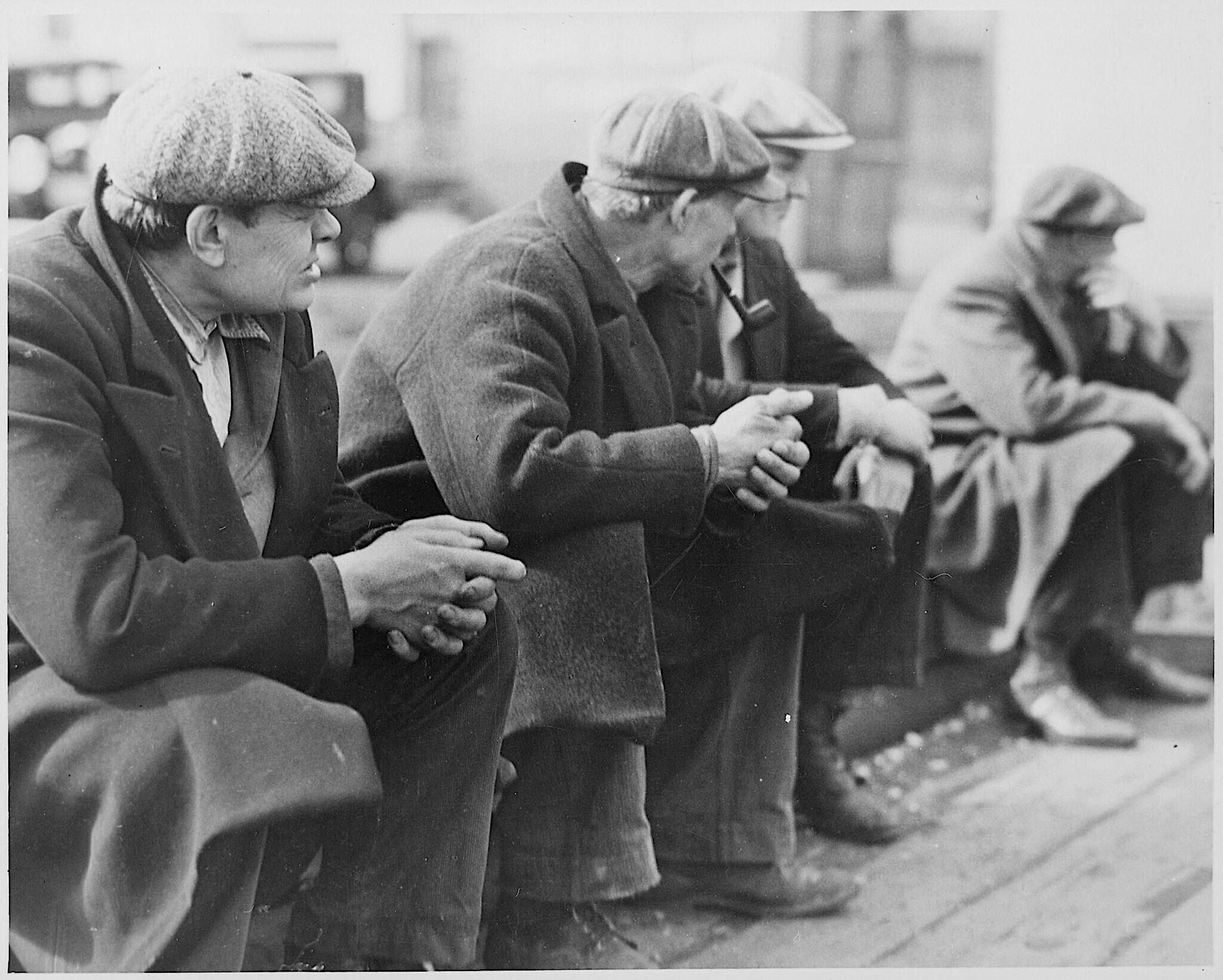
Row of men at the New York City docks out of work during the depression, 1934. (Lewis Hine, Flickr, U.S. National Archives)
In 1933, the height of the Great Depression, the U.S. unemployment rate reached a stunning 24.9 percent. In an eerie parallel with today, that double-digit increase had leapt from an era of remarkably low unemployment, 3.2 percent in the crash year of 1929. By mid-1931, mass layoffs were the new norm and despair was acute and widespread.
Fast forward to the present. In February, the unemployment rate stood at a similar 3.5 percent. Yet, by May 22, in the aftermath of city and state shutdowns and coronavirus shocks, including the collapse of the airline industry and professional sports, new filings for unemployment claims hit an estimated 40 million in 10 weeks, the most jobs lost in the shortest period in American history.
In April, the official unemployment rate reached 14.7 percent, the worst since the Great Depression, and that official figure doesn’t even account for the full scope of the disaster underway. It excludes workers the Bureau of Labor Statistics considers “marginally attached” to the workforce, meaning those not looking for a job because the prospects are so dim, or those who were only laboring part-time. If you factor them in, the unemployment rate already stands at a Great Depression-level 22.8 percent. Some industries, of course, felt more pain than others. Employment in the leisure and hospitality sector, for instance, fell in April by 7.7 million, or 47 percent.
Please Contribute to Consortium News’ 25th Anniversary Spring Fund Drive
Worse yet, low-wage workers have taken the hardest hit. According to a recent Federal Reserve survey, although 1-in-5 American workers have lost their jobs, among the lowest-earning Americans, 40 percent have done so. Among the highest-earning American workers (many of whom could work from home), the rate was “only” 9 percent.
Federal Reserve Bank of St. Louis President James Bullard has already predicted that the unemployment rate could reach 30 percent before the end of June. Other Fed economists have suggested that it could go even higher, exceeding Great Depression levels, a chilling thought. As the country, pushed by President Donald Trump’s reelection desires, “reopens” relatively quickly (at whatever cost in further Covid-19 deaths), many workers will undoubtedly be brought back or rehired, but there’s no avoiding the obvious reality that any number of “temporary” layoffs will become permanent realities.
The Economy: A Century Apart Yet Much the Same
When Covid-19 first hit and self-isolation set in, the stock market plunged and many businesses were forced to shut down normal operations. Various economists and media commentators then began musing about a V-shaped economic rebound — that is, a quick drop followed by a quick recovery.
As the fallout and uncertainty only expanded, however, it’s become increasingly evident that such a pattern was a fantasy. At this point, the best recovery outcome imaginable would be U-shaped in which the bottoming-out period lasted significantly longer before we started heading up again. But don’t count on that either. Consider the possibility of an elongated L, in which for the vast majority of Americans the economy just limps along for endless months, if not years (even if the stock market rallies).
In 1930, the American gross domestic product (GDP) shrank by 8.5 percent as the economy contracted in the wake of the stock market crash of 1929. It would shrink a further 6.4 percent in 1931 and another 12.9 percent in 1932. It wasn’t just the crash that did in that economy. The economic excesses of the 1920s and the borrowing that supported it were also responsible. Money funneled into the stock market in a previous age of inequality fueled grotesque financial speculation. Instead of financing productive investments, the markets provided only the illusion of stability and prosperity while enriching the few at the top. (Sound familiar in the age of Donald Trump?)
Yet the Republican president of that moment, Herbert Hoover, didn’t want to admit that the bottom had truly fallen out on his watch. On May Day 1930, for instance, he declared, “We have now passed the worst, and with continued unity of effort, we shall rapidly recover.” (Such a claim, too, should ring a few bells in 2020 America.) That statement became the marker for a nearly two-year Dow Jones average dive to a Depression-low of a mere 41 points on July 8, 1932. His inability to truly take in what was right in front of his eyes only lengthened the Great Depression.
Please Contribute to Consortium News’ 25th Anniversary Spring Fund Drive
Turning to the present, the CARES Act, signed into law by President Trump on March 27, unleashed an estimated $2.2 trillion in government relief (significant parts of which were aimed at giant corporations and the wealthy). That, combined with the Federal Reserve’s backing of the economy, could add up to perhaps $6.2 trillion. What promptly transpired for Wall Street, which had previously seen the Dow plunge 34 percent , was one of the best months for the stock market in more than 33 years.
Beltway leaders had learned the pivotal lesson of the moment: even if the market’s not the economy, it always craves more. They stood ready to green-light Wall Street with yet another stimulus package skewed to help corporate interests, even as the majority of Americans on Main Street were simply left further behind.
Meanwhile, the gross domestic product had fallen 4.8 percent in the first quarter of 2020, before Covid-19 and the corresponding social shutdown really hit hard. In other words, GDP for the second quarter of this year is guaranteed to be truly awful. Estimates of its contraction range from 20 percent to 30 percent, either of which would eclipse the contractions of the Great Depression era.
The Stock Market: A Casino Shadowing an Economic Problem
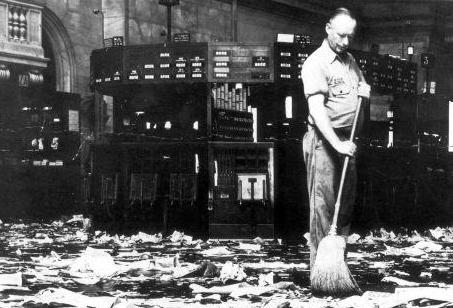
Sweeping up after the Wall Street crash, 1929. (National Archives, Flickr, Wikimedia Commons)
The Roaring Twenties claimed that moniker not just thanks to the free-flowing bootlegged booze but rampant financial speculation — and the lack of rules to protect citizens from nefarious Wall Street shenanigans. Having hit record highs in the summer of 1929, stock prices began their decline that September. By mid-October, the fall had gained steam. On Oct. 24, as panic set in on what would become known as “Black Thursday,” a then-record 12,894,650 shares were traded by investors and speculators seeking to lock in profits before the bottom fell out of the market.
By the next Monday — “Black Monday” — it had gone into free fall. And that would be followed by “Black Tuesday,” when stock prices plummeted yet further amid record trading volume. Billions of dollars were lost and thousands of investors wiped out. (Once upon a time, I even wrote a novel about that era called — you guessed it — “Black Tuesday.”)
By then, the Dow had dropped 24.8 percent in three days, though for several weeks thereafter stock prices would partially recover and bond prices rise on rumors that the Federal Reserve was going to purchase government securities. (Again, that should sound familiar in 2020.)
Bankers, then fortified by the Fed, did indeed inject yet more speculative money into the market in the post-crash moment, yet none of this could hide what were by then obvious systemic problems in the economy, which meant that prices soon headed south again. By July 1932, stocks were worth only 20 percent of their 1929 values and the country had plunged into the Great Depression. It would take years, substantive federal action, and ultimately an industrial mobilization for World War II to truly turn the situation around.
Fast forward to 2020. By March 23, when the coronavirus sell-off was underway, the Dow had lost about 35 percent of its value. Since then, equity markets, though down significantly from their February peaks, have rallied and the Dow has risen about 30 percent.
As in 1929-1930, this could all prove to be an illusion, especially since the market’s April rally did not reflect the longer-term economic issues that lie ahead. It was in large part a response to something that didn’t exist during those crash years of the Great Depression: an extremely amped up Federal Reserve.
The Fed: A Revamped Mechanism from the Last Depression
In the wake of the Crash of 1929, Wall Street bankers pushed the Fed to keep interest rates low so they could borrow money more easily to make up for their losses. In May 1932, the Fed finally initiated a massive bond-buying program, agreeing to purchase $26 million of them from its member banks each week.
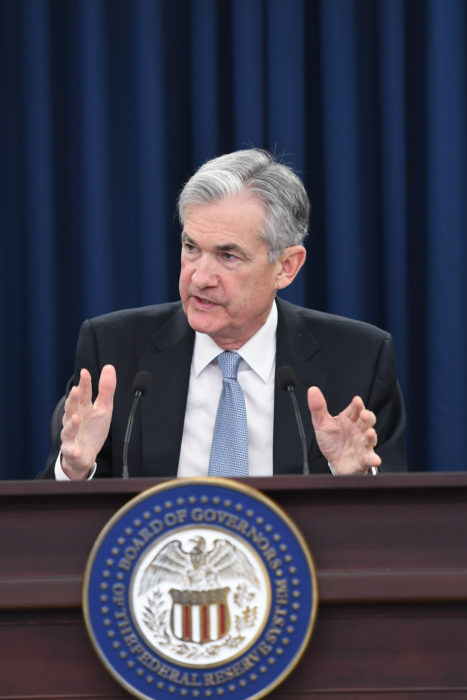
Jerome Powell. (Federal Reserve via Flickr)
The idea was that those banks would sell their U.S. Treasury bonds to the Fed and use that money to pay off their debts. They could then lend out the remaining cash to a desperate Main Street. As it happened, however, they didn’t launch such a generous loan program (another Great Depression reality that might ring a bell today).
The Fed eventually lowered rates from to 2.5 percent in 1934 to 1.5 percent in September 1937 to inject more money into the system. That did not, however, inspire an outpouring of lending either, nor did rates make it down to zero.
In the wake of the Covid-19 shutdowns, the Fed has indeed cut rates to zero. As Fed Chairman Jerome Powell said on May 13, “The scope and speed of this downturn are without modern precedent, significantly worse than any recession since World War II.” He added: “We have acted with unprecedented speed and force.” His counterpart, Treasury Secretary Steven Mnuchin, even termed what was going on “a war.”
Because of quantitative easing — the Fed’s purchasing of securities, a term that didn’t exist in the Great Depression era — its balance sheet now sits at nearly $7 trillion spent. That’s almost double the figure from just last summer and equivalent to one-third of the $21.5 trillion gross domestic product. The Fed has been injecting money into the markets and scarfing up securities backed by debt at — to steal a term the president only recently applied toward developing a coronavirus vaccine — “warp speed.”
With a genuine arsenal at its disposal to fight this “war,” the Fed’s activities are jacked up on the financial equivalent of steroids. The nation’s central bank is prepared to provide money to the financial system in quantities and ways unimaginable in the Great Depression era.
Why History Matters
What’s happening today is not, of course, a replica of the Great Depression. That nightmare was catalyzed by a prolonged market crash, thanks to banks lying about the real value of certain securities and too much debt in the system. Today’s crisis has been catalyzed by a viral pandemic spreading across the planet, by supply-and-demand shocks the world over, and by the collapse of a global economic system, as well as widespread lockdowns. Yet certain factors are common to both eras in which economic disaster was exacerbated by too much corporate debt, a Fed-stoked market rally, and grotesque levels of inequality.
“The Fed can electronically print money, but it can’t print jobs. It can buy bonds, but it can’t cure a virus. It can continue to try to stimulate the market, but it can’t banish fear.”
A century ago, the Fed put just a financial toe in the water to support the markets on the assumption that this would be enough to sustain the economy. Today, it has jumped in big time and Chairman Powell has vowed that it “is not going to run out of ammunition.” The result could be a financial tug of war that lasts years.
The Fed can electronically print money, but it can’t print jobs. It can buy bonds, but it can’t cure a virus. It can continue to try to stimulate the market, but it can’t banish fear. As it happens, the economy needs much more than Fed-style monetary support. As even Powell noted on May 13, “Additional fiscal support could be costly, but worth it if it helps avoid long-term economic damage and leaves us with a stronger recovery. This tradeoff is one for our elected representatives, who wield powers of taxation and spending.”
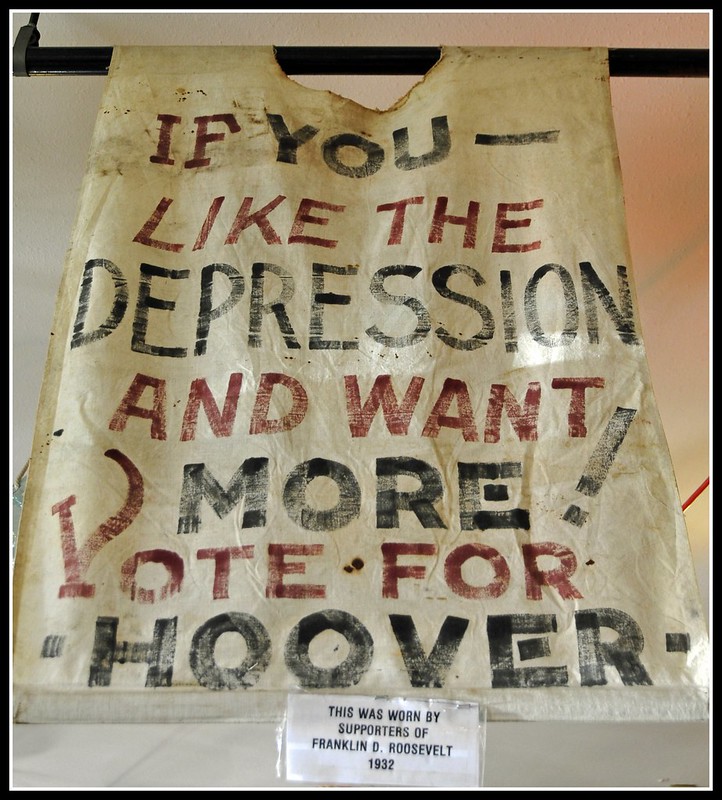
1932 presidential campaign gear, when Democrat FDR defeated Republican Herbert Hoover. (Tony Fischer, Flickr)
What’s needed, above all, is greater strategic action from Washington politicians who are more desperately divided and tribalized than ever in the Trump era. History tells us that political actions matter even more in times of crisis.
During the Great Depression, the state of the country became so bad that, in 1932, Herbert Hoover lost the presidential vote to Democrat Franklin Delano Roosevelt in a landslide. However, it took until 1934, even with a president ready to do much to help Americans in trouble, for the country to slowly emerge from the malaise.
Though unemployment remained near 22 percent then, the national mood lifted (and people started to spend again) in part thanks to growing confidence in President Roosevelt’s New Deal programs.
Those included the creation of the Tennessee Valley Authority — the nation’s first regional supplier of public power — numerous jobs programs, and the passage of the Social Security Act. Add to that the regulation of the banking system through the passage of the Glass-Steagall Act of 1933, which protected ordinary people’s bank deposits, and note as well that such forward-looking, economy-stabilizing programs were bipartisan acts.
In the face of devastation today, despite multi-trillion-dollar federal stimulus packages, real political action has been lackluster at best. Relief efforts have been skewed toward helping banks and big corporations rather than the Main Street economy. No substantive plan has been offered for real national action to get people working again in ways that would reflect the new norms of the Covid-19 era.
Roosevelt saw such an opportunity to bolster confidence by taking on banking reform (with the surprising help of bankers), launching public works initiatives, and establishing infrastructure programs meant to build up the nation, the very opposite of the speculative activity that enflamed the Crash of 1929. That’s just the sort of thing that’s needed to sustain the economy in our truly bad times (whether the coronavirus becomes seasonal or not).
Floating trillions to Wall Street banks and big corporations might push their share prices up, but it won’t solve the issues that truly matter. Struggling small businesses, stranded high school and college graduates with nowhere to land, and workers in devastated businesses that won’t see their jobs return any time soon are now guaranteed one thing: they’ll be left behind by just about any version of an attempted bipartisan “recovery.”
For them, a Newer Deal is desperately needed, one that provides a cushion for workers, new openings for the young, better healthcare prospects for all, and infrastructure projects that meet the challenges of a post-coronavirus world.
As President Roosevelt told Americans in the midst of the Great Depression: “There is a mysterious cycle in human events. To some generations much is given. Of other generations much is expected. This generation of Americans has a rendezvous with destiny.”
As long as Donald Trump is in the White House, focusing on optimizing his reelection prospects, he alone has a rendezvous with destiny. But it’s crucial, now more than ever, not to lose sight of the dream that tomorrow can be better than today. The only real way forward, in the end, is to meet the complex challenges of the Covid-19 moment with creative and long-lasting solutions.
Nomi Prins, a former Wall Street executive, is a TomDispatch regular. Her latest book is “Collusion: How Central Bankers Rigged the World.” She is also the author of “All the Presidents’ Bankers: The Hidden Alliances That Drive American Power” and five other books. Special thanks go to researcher Craig Wilson for his superb work on this piece.
This article is from TomDispatch.com.
The views expressed are solely those of the author and may or may not reflect those of Consortium News.
Please Contribute to Consortium News’ 25th Anniversary Spring Fund Drive



If you want a solution concentrate on a solution, or several solutions can be considered. leave the causes to be considered later.
A failure of government to prevent massive foreclosures will be far more of an issue than in 2008, because it has taken little action and still has no tracking to contain the epidemic, has doled out trillions to WallSt, and could just as easily enforce a mortgage moratorium. This time there is no WallSt shenanigan like securitized mortgages to blame it on, just government failures. People will know that the interest rate is zero for the rich, but credit is unavailable to the unfortunate, a clear theft by the rich.
Excellent article, Nomi’s Wall Street career has enabled her to be an outstanding analyst of its predatory intricacies.
A parallel, Hoover was unfairly blamed for the Great Depression; he only took office in 1929. His main fault was an inadequate hands off approach to the crisis, which just maintained the misery until Roosevelt took over.
The real culprit was his predecessor of six years, Calvin “keep cool with” Coolidge; who took a libertarian approach to the economy not even remotely contemplating remedying the building speculative bubble, high margin debt and other risks.
Reagan considered him an economic role model as well as for labor relations. Coolidge was infamous for firing the entire Boston Police Force for going on strike when he was Massachusetts governor-it must have been a good time to be a criminal. Reagan, as those of us who remember, fired the air traffic controllers when they went on strike- not a confidence inspiring time to fly.
Reagan was lucky in his bogus “trickle down theory” only resulted in a recession at the end of his term not a full blown whopping depression.
What seems to not be considered here about this showering of so much cash on the bankers, hedge fund managers, plutocrats and other socially unnecessary parasites is what they’ll do with the loot. As Dylan Ratigan and Jimmy Dore point out repeatedly, this represents the beginning of what will become the largest upward transfer of wealth in history. How? The financial parasites will use the windfall to buy up bankrupted businesses and bankrupted homeowners all over the country — at fire sale prices. That’s when the real heist will happen, and it will make the 5.4 million foreclosures of 2008-09 look like a children’s picnic. Is there any reason to think this scenario won’t play out? It’s very hard to think of one.
“A sad soul can kill you quicker than a germ.” – John Steinbeck
And we have not only crushing sadness, but also germs to deal with.
There are even millions that are not only unemployed, but they can’t even get their unemployment checks, which they paid for, even after two or three months. I just don’t get the feeling that, given the grotesque inequality that seems to be just accelerating, that Mnuchin, Trump, and the Democrats will agree to a needed big newer deal. The grapes of wrath will only be for the 99 percent, any CARES sequel will more than anything, be more gifts for the super rich, and just have a few more crumbs for the rest of us. All of the grandiose platitudes of the politicians are always watered down in the final details. And it’s definitely much harder for those in poverty to practice the necessary social distancing and self-quarantining and all that, so it’s really a recipe for a long-lasting disaster, this is the perfect storm and I shudder to imagine what kind of destiny our generation will rendezvous with.
Excellent article very soundly reasoned, but with the flawed conclusion that Trump is the problem.
The only realistic alternative to Trump is even worse than Trump!
President Roosevelt had to scratch and claw to get what he wanted done. Wall Street tried to curtail the New Deal and somehow the President managed to prevail even with a coup staged against him. Was it easier to prevail then than it is now? Anyone that thinks we have recovered from the recession of 2008 hasn’t learned enough of the full story. There were no checks sent out to the population with O. as President. A couple hundred, if I recall correctly, under W. (Guilty peanuts). They didn’t acknowledge their mishandling of it. They didn’t care. Now, many people, in nursing homes and unemployed, are losing it and it is time to live again with normal operations and chancing life over death.
All good but stop blaming it all on Trump. He is utterly detestable, incompetent, and self-centered, which perfectly aligns him with 98% of politicians. Dems and Reps alike couldn’t wait to shower Wall St. with trillions while hanging citizens out to dry.
Bernie, in one of his Covid-19 forums, hosted Sara Nelson, International President of the Association of Flight Attendants – CWA, AFL-CIO, to argue the point (that Sanders and his like minded legislators are pushing) that the airlines should not be bailed out unless the terms included keeping the employees employed.
I read that the legislation, the Cares Act protected pilots, flight attendants and some others (not everyone working at airports) for a period of time….
I’m sure it’s not enough…..